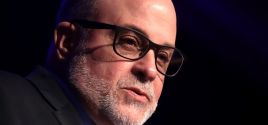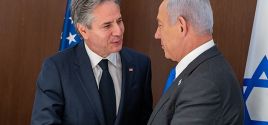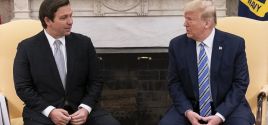Holland To Allow ‘Baby Euthanasia’Matthew Campbell, GroningenThe Sunday Times Mar. 05, 2006 |
Popular 
'We Own This Country': Mark Levin Says Pro-Palestine Protesters Should be 'Rounded Up and Deported'

Zionist Mob Attacks Pro-Palestine Protesters at UCLA While Screaming 'Second Nakba'

Israel-Ukraine $95B Aid Bill Includes Provision to 'Supercharge Mass Migration From the Middle East'

"I've Never Seen This Many Police": NYPD Launch Crackdown on Pro-Palestine Protesters at Columbia

Trump Meets With DeSantis in 'Quest for Donors,' Calls for Protests to be Shut Down One Day Later
 WHEN Frank and Anita’s daughter Chanou was born with an extremely rare, incurable illness in August 2000, they knew that her life would be short and battled against the odds to make it happy. They struggled around the clock against their baby’s pain. “We tried all sorts of things,” said Anita, a 37-year-old local government worker. “She cried all the time. Every time I touched her it hurt.” Chanou was suffering from a metabolic disorder that had resulted in abnormal bone development. Doctors gave her no more than 30 months to live. “We felt terrible watching her suffer,” said Anita at their home near Amsterdam. “We felt we were letting her down.” Frank and Anita began to believe that their daughter would be better off dead. “She kept throwing up milk that was fed through a tube in her nose,” said Anita. “She seemed to be saying, ‘Mummy, I don’t want to live any more. Let me go’.” Eventually, doctors agreed to help the baby die at seven months. The feeding was stopped. Chanou was given morphine. “We were with her at that last moment,” said Anita. “She was exhausted. She took a very deep last breath. It was so peaceful. It made me feel at peace inside to know that she wasn’t suffering any more.” Even so, they felt that the suffering had gone on too long. Child euthanasia is illegal in Holland and doctors were afraid of being prosecuted. “It was a long road to find the humane solution that we reluctantly decided we wanted,” said Frank, a bank worker. Each year in Holland at least 15 seriously ill babies, most of them with severe spina bifida or chromosomal abnormalities, are helped to die by doctors acting with the parents’ consent. But only a fraction of those cases are reported to the authorities because of the doctors’ fears of being charged with murder. Things are about to change, however, making it much easier for parents and doctors to end the suffering of an infant. A committee set up to regulate the practice will begin operating in the next few weeks, effectively making Holland, where adult euthanasia is legal, the first country in the world to allow “baby euthanasia” as well. The development has angered opponents of euthanasia who warn of a “slippery slope” leading to abuses by doctors and parents, who will be making decisions for individuals incapable of expressing a will. Others welcome more openness about a practice that, according to doctors, goes on secretly anyway — even in Britain — regardless of the law. “It is a giant step forward and we are very happy about it,” said Eduard Verhagen, clinical director of paediatrics at the University Medical Centre in Groningen, northern Holland. Anti-euthanasia campaigners have been addressing hate mail to “Dr Death”, as they call him, ever since he admitted having personally overseen four “assisted neo-natal terminations”. He then began drawing up guidelines for doctors carrying out euthanasia on babies. It forced the government to confront the issue and Verhagen’s so-called “Groningen protocol” has been adopted as the standard to be upheld by the regulatory committee. It emphasises that life can be ended only in cases involving “unbearable suffering”, with parental consent and after consultation with other physicians. “If a child is untreatably ill,” Verhagen explained, “there can be horrendous suffering that makes the last few days or weeks of this child’s life unbearable. Now the question is: are you going to leave the child like that or are you going to prevent that suffering?” He went on: “Does the child have to sit it out until the end? We think that the answer is no. There can be circumstances where, under very strict conditions, if all the requirements are fulfilled, active ending of life can be an option — but only in cases of untreatable disease and unbearable suffering.” A visit to Groningen’s intensive care unit for children last week demonstrated how rare it is for infants, in an age of extremely sophisticated, high-tech medical treatment, to experience extreme pain. Even so, life and death decisions are made by doctors every day. Consider Maryline, only a few hours old, who lay in an incubator on Wednesday afternoon after being born prematurely. With feet smaller than adult thumbs, she was breathing through a respirator as doctors struggled to get her little lungs working on their own. “At some point,” said Verhagen, observing this battle for life, “we will have to decide whether it is pointless from a medical point of view and whether we should not prolong treatment.” This, he agreed, was a form of “passive euthanasia” practised in countries all over the world. But from a moral point of view, he argued, it was no different from administering a lethal dose of morphine, since the result of withdrawing treatment would also eventually be death. “Is there any difference between watching someone drowning without doing anything and pushing them into the lake?” he asked. Verhagen, a 42-year-old father of three who has spent years tending sick children in underdeveloped countries, became a paediatrician with the intention of saving children’s lives, not ending them. Then along came a case that changed his entire way of thinking. Sanne had a severe form of Hallopeau-Siemens syndrome, which meant that her skin would detach itself from her body if anyone touched it. The membranes inside her mouth and oesophagus fell away whenever they tried to feed her through a tube. To experts, it is obvious when babies are in pain, and not only because of the type of shrieking. The way they clench their fists is another indicator. This was a child in great pain but pain relievers seemed to make no difference; and every time nurses replaced her bandages a little more of her skin fell off. She came to resemble a mummy. Verhagen did not know what to do. Her parents demanded an end to her suffering and, for the first time in his career, Verhagen considered euthanasia. Fearing prosecution, however, he sent the child home, where she died of pneumonia six months later. Verhagen believed he had let down the girl and her parents by allowing such suffering. “We were very unhappy,” he said. He and his colleagues began liaising with the local prosecutor, even inviting him to come on hospital rounds to familiarise himself with some of the issues involved. The hospital began reporting cases of euthanasia in newborns with spina bifida between 2002 and 2004. Verhagen authorised and sometimes witnessed the procedure without any criminal charges being brought against him. “It is in some ways beautiful,” said Verhagen, describing the moment when severely pain-racked children relax for the first time since birth. “But it is also extremely emotional and very difficult,” he added. “No doctor likes to do this. You will always ask yourself, ‘Is there something I have not thought of?’ That is why it needs to be done under a spotlight: you can never, ever be wrong.” His approach has enraged a vociferous pro-life movement, particularly in America where it has been compared to a campaign by the Nazis to dispose of handicapped infants in the interest of building a master race. Dutch doctors, wrote one commentator in the conservative Weekly Standard magazine, were engaging in “the kind of activities that got some German doctors hanged after Nuremberg”. In liberal Holland, criticism is more muted. But Bert Dorenbos, chairman of the Cry for Life organisation, called tolerance of child euthanasia “very scary”. “It is a terrible thing,” he said. Under the new system “patients, particularly children, will need protection from euthanasia-minded doctors. It is very worrying indeed”. Verhagen accepts that not everybody feels as he does about euthanasia. “So that’s why we say that deliberate ending of life is never a must. But it can be an option, so long as parents as well as physicians and others are in agreement that it should be an option.” If it were one of his own children, he would not hesitate to ask a doctor to step in, although he would not be able to combine the role of father and doctor. “I would go to see my doctor and say I think my child is better off dead than alive and the option would be there. So it gives me a certain peace of mind.” Frank and Anita see doctors such as Verhagen as heroes for being brave enough to advocate death in cases such as the suffering of their daughter. “Ultimately, why should such a tiny little girl have to suffer such unbearable pain?” said Frank. Nevertheless, it had been “a real struggle to arrive at this position and then to decide to act on it”. After her daughter’s death, Anita became pregnant again but a test at 11 weeks showed her child to be suffering from the same metabolic disorder as Chanou and she had an abortion. Then she gave birth to Damian, a healthy toddler. The couple planted a lime tree for Chanou in a park in southern Holland and go there often to remember their “brave little fighter”. A photograph of her, taken during a lull in her battle with pain, shows a faint smile on her face. Anita has no regrets about what happened: “She is playing in heaven now.” |



